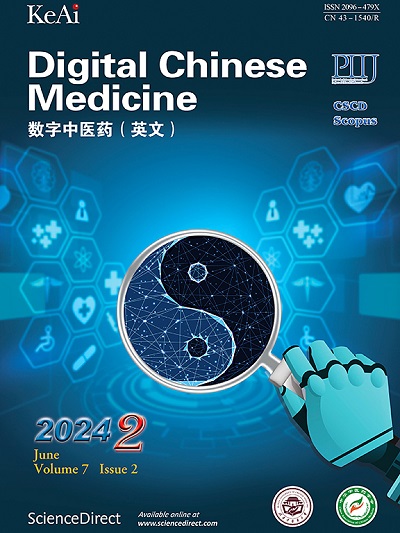Differential expression profiles analysis of DNA methylation between “disease” and “syndrome” in coronary heart disease-induced unstable angina patients with Qi deficiency and blood stasis syndrome
Q3 Medicine
引用次数: 0
Abstract
Objective
To explore the differential expression profiles of DNA methylation sites/regions and potential molecular mechanisms in the peripheral blood of coronary heart disease (CHD)-induced unstable angina pectoris patients with or without Qi deficiency and blood stasis syndrome, and to provide scientific evidence for the conbination of disease and syndrome.
Methods
According to the pre-determined inclusion and exclusion criteria, the study subjects were enrolled and divided into two groups namely CHD-induced unstable angina group (G group) and healthy control group (J group) to conduct “disease” analysis, while G group was further divided into Qi deficiency and blood stasis syndrome group (case group) and non-Qi deficiency blood stasis syndrome group (control group) to perform “syndrome” analysis. The general data and clinical information of the study subjects were collected. The peripheral venous blood was extracted on an empty stomach, and the Illumina Infinium MethylationEPIC BeadChip (850K methylation chip) was used to detect the differential expression profiles of DNA methylation in each group, ChAMP software (V 2.14.0) was used for the differential methylation data analysis, with a threshold of the adjusted P value (adj.P.val) < 0.01. Gene Ontology (GO) and Kyoto Encyclopedia of Genomes (KEGG) were employed for the functional and pathway enrichment analyses of related mapped genes.
Results
A total of 263 differentially methylated CpG positions (DMPs) were screened out between G and J groups, including 191 hypermethylated positions such as cg05845204 and cg08906898, and 72 hypomethylated positions such as cg26919182 and cg13149459. These positions were mainly mapped to 148 genes encompassing RNA binding motif protein 39 (RBM39), acetyl-CoA acyltransferase 2 (ACAA2), protein phosphatase 1 regulatory subunit 12B (PPP1R12B), and the dual-specificity tyrosine phosphorylation-regulated kinase 2 (DYRK2). GO functional enrichment analysis revealed that the genes of the DMPs were primarily enriched in protein localization to chromosomes, regulation of cell morphogenesis, negative regulation of calcium-mediated signals, etc. KEGG pathway analysis suggested that the genes were mainly enriched in fatty acid metabolism and endocytosis pathways. In addition, a total of 23 differential methylation regions (DMRs) were identified, with overlapping genes such as transmembrane protein 232 (TMEM232), ribosomal protein large P1 (RPLP1), peroxisomal biogenesis factor 10 (PEX10), and forkhead box N3 (FOXN3) recognized. It was found that GO functions were mainly enriched in the negative regulation of Ras protein signal transduction, small GTPase-mediated signal transduction, negative regulation, etc. A total of 1 703 differential methylation sites were screened out between case and control groups, including 444 increased methylation positions such as cg05573767 and 1 259 decreased methylationpositions such as cg19938535, and cg03893872. These positions were mapped to 1108 genes such as ribosomal protein S6 kinase A2 (RPS6KA2), leucine rich repeat containing 16A (LRRC16A), and hedgehog acyltransferase (HHAT). According to the GO functional enrichment analysis, the genes relating to the DMPs were mainly enriched in biological functions such as transmembrane receptor protein serine/threonine kinase signaling pathway and axonogenesis. The KEGG pathway enrichment analysis suggested the involvement of Rap1 signaling pathway, adenosine 5’-monophosphate-activated protein kinase (AMPK) signaling pathway, etc. A total of 21 DMRs were identified, including 22 overlapping genes such as mucin 4 (MUC4), three prime repair exonuclease 1 (TREX1), and LIM homeobox 6 (LHX6). GO analysis demonstrated that the genes primarily participated in molecular functions such as positive regulation of transmembrane transport, regulation of fatty acid metabolism, and copper ion binding.
Conclusion
This study reveals the methylation patterns of DMPs and DMRs in patients with Qi deficiency and blood stasis syndrome caused by CHD-induced unstable angina pectoris. Potential epigenetic regulation of fatty acid metabolism, Rap1 signaling, and other molecular functions are involved in the development of CHD between the "disease" and "syndrome".
冠心病不稳定型心绞痛气虚血瘀证患者“病”与“证”DNA甲基化差异表达谱分析
目的探讨冠心病(CHD)致不稳定型心绞痛伴气虚血瘀证患者外周血DNA甲基化位点/区域的差异表达谱及可能的分子机制,为病证结合提供科学依据。方法根据预先确定的纳入和排除标准,纳入研究对象,分为冠心病不稳定型心绞痛组(G组)和健康对照组(J组)两组进行“病”分析,G组进一步分为气虚血瘀证组(病例组)和非气虚血瘀证组(对照组)进行“证”分析。收集研究对象的一般资料和临床资料。空腹提取外周静静脉血液,采用Illumina Infinium MethylationEPIC BeadChip (850K甲基化芯片)检测各组DNA甲基化差异表达谱,采用ChAMP软件(V 2.14.0)进行差异甲基化数据分析,阈值为调整后的P值(adj.P.val) <;0.01. 利用基因本体(GO)和京都基因组百科全书(KEGG)对相关定位基因进行功能和途径富集分析。结果共筛选出G组和J组CpG差异甲基化位点263个,其中高甲基化位点(cg05845204、cg08906898) 191个,低甲基化位点(cg26919182、cg13149459) 72个。这些位置主要定位到148个基因,包括RNA结合基序蛋白39 (RBM39)、乙酰辅酶a酰基转移酶2 (ACAA2)、蛋白磷酸酶1调节亚基12B (PPP1R12B)和双特异性酪氨酸磷酸化调节激酶2 (DYRK2)。氧化石墨烯功能富集分析显示,dmp基因主要富集于染色体蛋白定位、细胞形态发生调控、钙介导信号负调控等方面。KEGG通路分析表明,这些基因主要富集于脂肪酸代谢和内吞途径。此外,共鉴定出23个差异甲基化区(DMRs),识别出跨膜蛋白232 (TMEM232)、核糖体蛋白大蛋白P1 (RPLP1)、过氧化物酶体生物发生因子10 (PEX10)、叉头盒N3 (FOXN3)等重叠基因。发现氧化石墨烯的功能主要富集在Ras蛋白信号转导的负调控、小gtpase介导的信号转导、负调控等方面。共筛选出1 703个差异甲基化位点,包括444个甲基化升高位点(cg05573767)和1 259个甲基化降低位点(cg19938535、cg03893872)。这些位置被定位到1108个基因,如核糖体蛋白S6激酶A2 (RPS6KA2)、富含亮氨酸的重复序列16A (LRRC16A)和刺猬酰基转移酶(HHAT)。根据氧化石墨烯功能富集分析,与dmp相关的基因主要富集于跨膜受体蛋白丝氨酸/苏氨酸激酶信号通路和轴突发生等生物学功能。KEGG通路富集分析提示参与Rap1信号通路、腺苷5′-单磷酸活化蛋白激酶(AMPK)信号通路等。共鉴定出21个DMRs,包括22个重叠基因,如mucin 4 (MUC4)、three prime repair exonucase 1 (TREX1)和LIM homobox 6 (LHX6)。氧化石墨烯分析表明,这些基因主要参与跨膜运输的正调控、脂肪酸代谢的调控、铜离子结合等分子功能。结论本研究揭示了冠心病不稳定型心绞痛气虚血瘀证患者dmp和DMRs的甲基化模式。脂肪酸代谢、Rap1信号传导等分子功能的潜在表观遗传调控参与了冠心病在“病”与“证”之间的发展过程。
本文章由计算机程序翻译,如有差异,请以英文原文为准。
求助全文
约1分钟内获得全文
求助全文
来源期刊

Digital Chinese Medicine
Medicine-Complementary and Alternative Medicine
CiteScore
1.80
自引率
0.00%
发文量
126
审稿时长
63 days
期刊介绍:
 求助内容:
求助内容: 应助结果提醒方式:
应助结果提醒方式:


